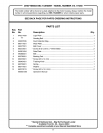
LOCKINGONTHE SANDER
See Figure 8.
The lock-on feature allows you to lock the trigger switch
in the On position. Locking the trigger switch on allows
you to operate the sander for extended periods of time.
If you have the lock-on feature engaged during use and
the sander is accidentally disconnected from the power
supply, disengage the lock-on feature immediately.
Also, do not lock the trigger switch if you might need to
suddenly stop the sander.
,_ WARNING: Before connecting the sander to a
power supply, make sure it is not in the locked-on
position. Failure to do so could result in accidental
starting of the tool resulting in serious injury.
Follow these steps to lock on the sander.
• Depress the trigger switch.
• Push in the lock-on button.
• Release the trigger switch.
• Release the lock-on button.
Note: To release the lock, depress the trigger
switch.
OPERATING THE SANDER
See Figure 9.
Follow these steps to operate the sander.
• Secure the work to prevent it from moving under the
sander.
_L WARNING: Unsecured work could be thrown
towards the operator causing injury.
• Turn the sander on and let the motor reach its
maximum speed before placing the sander on the
work surface.
• Lower the sander to the work surface with a slight
forward motion.
• Move the sander slowly over the work surface,
using the rear handle to control the sander and the
front handle to guide the sander.
Note: Allowing the sander to remain in one place
will result in an uneven surface.
_, WARNING: Keep a firm grip on the sander with
both hands at all times. Failure to do so could
result in loss of control leading to possible serious
injury.
We designed the sander to provide the proper weight on
the sanding belt. Excessive pressure will result in the
following:
• Uneven work
• Clogged sanding belts
• Premature sanding belt wear
• Possible motor burnout
• Irregular sanding belt tracking
Fig. 9
13


















